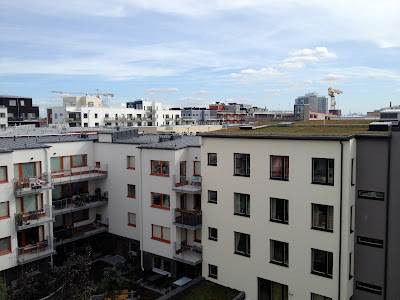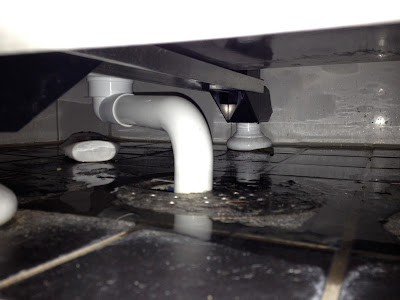Swedish/ Scandinavian sustainability, design, construction, and culture with a specific focus on sustainable cities and neighborhoods in Malmo and Stockholm (Vastra Hamnen, Augustenborg, Rosengard, Hyllie, Sege Park in Malmo. Hammarby Sjostad, the Royal Seaport in Stockholm). Boston sustainable thinking and practice. Bringing home ideas from forward thinking, advanced cultures, focused on building our sustainable future
Showing posts with label Vastra Hamnen. Show all posts
Showing posts with label Vastra Hamnen. Show all posts
Saturday, September 21, 2013
Green Triple Decker Pilot Program - the catalyst
we needed a catalyst, something to get us moving in the right direction or maybe something to get us to pull the trigger, to spend money, and to do the most sustainable project we could afford. most great projects and ideas need a catalyst. as you may recall, the Bo01 project in Malmo, Sweden used the European Housing Exposition as it's catalyst for masterplanning the Vastra Hamnen neighborhood and specifically constructing the European Village (note: if you are bored reading my description which was a combination of amazement, awe, and excitement, read this more down to earth, fact filled description). our Jamaica Plain condo upgrade catalyst started out casual and became very real very fast.
a casual meetup on the front porch over a beer got the deeper conversation started about sustainable living and fixing up our house(s). every one of the owners (one condo owner per floor) wanted to do something significant to improve each unit as well as the property overall. this meant coming up with individual strategies as well as thinking about overlap and shared strategies. in the end we wanted our individual condos to be more comfortable, efficient, and livable and we wanted the whole building to be a great place to call home. we immediately started talking about the building envelope, about super insulation, and about reduction of energy needs and energy use. everyone agreed that energy efficiency and sustainability were important, but we didn't know exactly how we would take it to the next level.
one of our crew stumbled upon an announcement from the City of Boston about a "Green Triple Decker" Pilot Program, orchestrated by the BRA. this program was exactly the catalyst we were looking for to get us going forward. the City of Boston (along with the energy utilities - NSTAR and NGRID) was offering up to $30,000 to deep energy retrofit approximately 5 triple deckers in Boston. according to the rules, there would be a preliminary application to narrow down the candidates. once selected, representatives from the City would work with the homeowners to develop a scope of work that attempted to achieve a HERS rating of 65 or better.
HERS is a system that started in California in 2006 and is now respected across the globe as a method to attach home value (price) to energy use and consumption. HERS (home energy rating system) basically takes a baseline (bare minimum) typical, wood stud, pink insulation home from 2006 and calls that 100 (as in 100%). that typical house uses 100% energy. a worse house (energy wise) uses more than 100 and a better house uses less. according to this scale, a zero energy house scores a ZERO on HERS and a typical 2006 house scores 100. an energy star house is 85 (15% better than a typical 2006 home). the program we were applying for through the City of Boston aimed at 65 (35% better than a typical 2006 home). our house existing 1000 sf condo, built in 1905 without insulation, would eventually be measured by an official HERS rater. our unit topped out at 135 (35% worse than a typical home). going from 35% worse than a new home to 35% better must be a piece of cake, right?
department of energy's description of curio.
we applied for the program, ended up on the short list, and eventually were awarded one of five grants to deep energy retrofit our 1905 Jamaica Plain condo. the next part was the hardest part. we knew the windows and doors were terrible, that there was virtually no insulation, and that the systems were old and wasteful. we just needed to figure out what to do, how to do it, where to invest, and how to stretch as far as we could...
to be continued...
Labels:
Bo01,
Boston,
European Housing Exposition,
European Village,
Green Triple Decker,
HERS rating,
Jamaica Plain,
Malmo,
neighborhood,
residential,
Sweden,
triple decker,
Vastra Hamnen,
zero energy neighborhood
Location:
Jamaica Plain, Boston, MA, USA
Tuesday, October 2, 2012
a dip in the Oresund Strait before sunset
the day after I took a walk along the western edge of Daniaparken in Bo01, I stumbled across a series of people jumping (or dipping) into the ocean. when I arrived at a stepped stonework area that led directly into the ocean, I knew this was the place. the water must be cold, but if they are doing it, I try it too. I pedaled home as quickly as possible. even me, a crazy person who is willing to jump in the cold waters of Sweden, knows that scary monsters inhabit the ocean after dark.
I returned with a backpack loaded with a towel and an ice cold 50 cl (500 ml) Swedish beer. I leaned the bike against the concrete wall, stripped down to my suit, carefully removed my flippie floppies, and waded ankle deep onto the wooden platform. I stood for quite some time, skeptical of the temperatural (yes, that is definitely a word) effect of the sea on my body. finally, after courage came and went several times, I swan dived into the icy blue water...
 |
| the aftermath of a dip in the ocean before sunset, as evidenced by flip flops and beer |
nothing solves the world's problems like taking a dip in the ocean at sunset and drinking a cold beer.
Labels:
Bo01,
Malmo,
neighborhood,
Vastra Hamnen,
water features,
water use
Location:
Daniaparken, Hamnen, Malmö, Sweden
Monday, October 1, 2012
sunset in Vastra Hamnen
as the sun began to dip lower in the sky, I made my way along Ribersborg beach, aiming back toward Vastra Hamnen. I stopped several times along the way to admire the kite surfers. or are they called wind surfers. judging by the amount of wind along the Western Harbor, this must be a great place to surf, regardless of what it's called.
 |
| if you google kite surfing while in Sweden, "kitesurf Sweden" comes up second, behind only the wikipedia page. clearly there is a lot of wind here, even if Malmo is not listed as one of the hotspots. |
 |
| people eating, drinking, and watching the sunset on the western edge of Daniaparken in Vastra Hamnen |
 |
| people eating dinner as the sun set in Vastra Hamnen along the edge of the Oresund Strait |
I passed by the corner building of Bo01 that houses Salt Och Brygga, a well known eatery anchoring the restaurants along the waterfront's western edge.
this building is known for two things besides the restaurant: 1. it is the least energy efficient building in Bo01 according to post occupancy studies. 2. it has a giant vertical solar thermal array that ended up being slightly under efficient because its evacuated tubes partially shade themselves.
as I continued north along the water's edge, I stopped to capture the sun as it dropped lower in the sky and highlighted the Oresund Bridge.
a Finnlines ship, which seemed to arrive in the harbor at least once per day, slipped under the sun toward the north harbor, the only area of the harbor that remains industrial in the 21st century.
 |
| one of the most notable buildings in Bo01 is the building that houses Salt och Brygga (salt and bridge), a well known restaurant marking the corner of the first phase of Vastra Hamnen, easily picked out in photographs due to the giant wall of solar thermal "panels" on the southwest corner of the building |
 |
| sunset along the Oresund Strait with the Bridge to the left |
 |
| Finnlines ship sliding along under the setting sun in Oresund |
 |
| Finnlines ship passing just north of Vastra Hamnen |
Labels:
Bo01,
energy production,
Malmo,
neighborhood,
renewable energy,
solar energy,
solar thermal,
Vastra Hamnen,
water features,
water use,
zero energy neighborhood
Location:
Barometergatan 80, 211 17 Malmö, Sweden
Thursday, September 27, 2012
Turning Torso: the anchor of Vastra Hamnen
you can't spend several weeks in Malmo and not take pictures of the Turning Torso. in fact, many would argue you can't spend several hours in Malmo and not take pictures of it. you may even recall that I took a picture of it the first night I arrived in Malmo. once the tallest apartment building in Europe, the Turning Torso twists upward 54 stories and 623 feet, the top floor at a 90 degree angle from the ground floor. the Torso was envisioned by the government of Malmo as a new beginning, a fresh start, and a much needed strengthening of the skyline to the north of the city center. it rises 2 times higher than Kronprinsen, the previous tallest building in Malmo.
 |
| the Turning Torso approached from the southern main access road to Vastra Hamnen from the city center. the Torso, designed by Santiago Calatrava, rises 623 feet and 54 stories. |
 |
| looking up at the Torso from the street |
- improve education and heighten the focus of the city on advanced education
- strengthen connectivity and interconnectedness of Malmo within the region of Skane and beyond
- use sustainability and sustainable initiatives as a method to advance the city and its planning
these three objectives were simultaneously addressed starting in the 1990's and moving into the first decade of the 21st century. though the Turning Torso was not, in itself, a cornerstone of any of these three specific objectives, it played a significant role as a new symbol of Malmo, the city of the future. the Torso is an excellent example of how cities use architecture (tall, unique, or important buildings, often designed by famous architects) to promote an agenda and "put themselves on the map" as Malmo has been doing for the last 15-20 years.
 |
| Turning Torso in Vastra Hamnen, Malmo as seen from the neighborhood |
1. one of the brightest examples of the city of Malmo putting a new focus on higher education was the creation of Malmo's first University, Malmo Hogskola. the University, now a central hub of the Dockans neighborhood adjacent to the central train station and Vastra Hamnen, has grown to more than 24,000 students in just over ten years of operation (the school opened officially in 1998). the school has many disciplines and areas of study, including several in sustainability such as master's degrees in "Leadership for Sustainability" and "Sustainable Urban Management".
 |
| the style has been called "structural expressionism" and is most evident in the exposed structural elements on the building exterior |
 |
| the Turning Torso sits in a pool of water at the base (the parking complex in the background contains a sustainable grocery store and restaurant on the ground floor) |
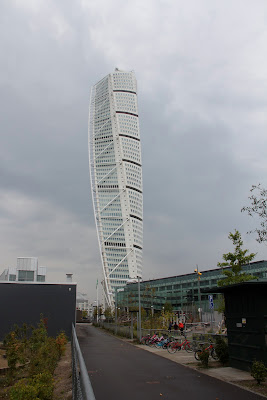 |
| the Turning Torso as seen from the neighborhood school. the top is 90 degrees twisted from the base. |
Wednesday, September 26, 2012
bike repair in Malmo - Part Two - "the cycle kitchen"
if you missed the exciting beginning of the story of the flat tire, here's Part One.
Part Two:
so the all day conference on Monday ended at 17.30 and I hopped on the train in Hyllie (by the way, it's not pronounced "hill e" as I was saying for the first few days when I arrived here in Malmo. it's actually pronounced "hill you" in a kind of french manner where they roll the tongue during the you part). I was home in less than 35 minutes after a quick train ride and a quick bus trip. the transport was free because the conference gives every participant a 72 hour free public transportation card! imagine that... the conference you are attending in a city offers a free method to use public transportation. what a nice idea... thanks Malmo!
 |
| Stapelbaddsparken building (underneath where ships were pushed out to sea from the shipbuilding port, Dockan) is now a hub for local non profits in Malmo, including cykelkoket, the cycle kitchen |
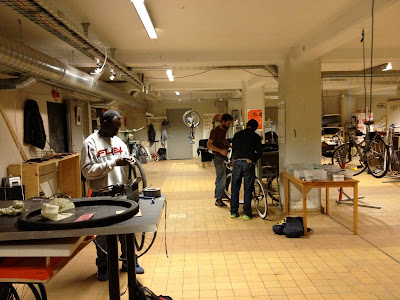 |
| cykelkoket (the cycle kitchen) in Dockan where free tool time combined with volunteer bike experts leads to an amazing experience |
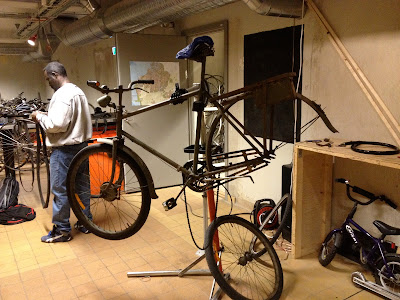 |
| work being done to fix up a Swedish military bike which are surprisingly common in Malmo. the guy fixing it up comes to cykelkoket every monday night to work on it. he bought it on Craigslist. he was riding it around the city with no brakes for awhile. |
 |
| some of the free tools available for use to fix up your bike. the shop also collects and fixes up old bikes that have been confiscated by the city or abandoned. |
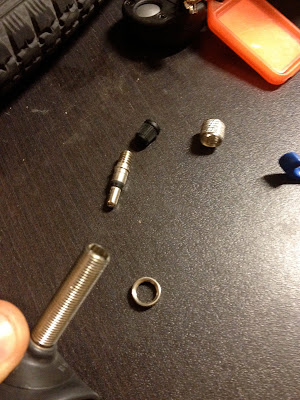 |
| most common style of valve stem in Sweden is actually English, called the Dunlop valve. in the US, almost all tubes have a German or Italian style (Schrader or Presta). I had never seen this English version before. |
 |
| recycling at the cycle kitchen |
 |
| Bert, a volunteer for cykelkoket, helped me solve what turned out to be a very complicated flat tire (I don't think I have ever heard the words complicated and flat tire in the same sentence) |
Monday, September 17, 2012
food scraps = energy in Malmo: the food grinder
it's 6.30pm and you just arrived home from work. it's time to make dinner. it is a simple meal. pasta with veggies and sauce. you pull out the cutting board and your favorite knife. you scrub all of the terrible pesticides and toxins off your vegetables, hoping that this shiny red pepper is not the one that puts one nano gram too much of whatever you don't want in your body. you chop and cut and chop and suddenly you are sauteing it all in a pan. the water is boiling for the pasta and voila! you have dinner. it's delicious, by the way.
cleanup in this kitchen is almost as easy as making the mess. you finished the pasta sauce so you splash some water around in the jar and dump it down the drain. you open the door under the sink and deposit the jar into the clear glass recycling bin. the scraps of vegetables go into the food grinder (what we used to call the garbage disposal). you splash a little water on the plates and silverware and put it all in the dishwasher. you always win the clean plate award so there are no scraps on the plate, but if there were any scraps or anything else that could be ground in the food grinder, you'd dump them into the sink and wash them "away" as well.
 |
| kitchen sink in the apartment. pretty "normal" looking. the silver button on the upper left turns on the food grinder. |
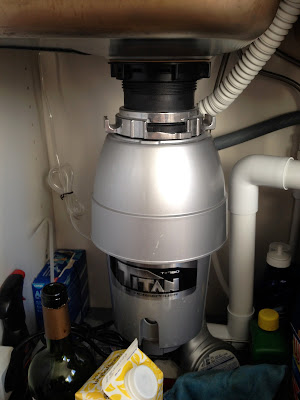 |
| it's a titan. food grinder. |
- "clean" (meaning that the stuff that goes into the food grinder is food, not plastic or other undesirable items that dilute or destroy the biogas process)
- hygienic for the inhabitant (what you put into the grinder is what you have already touched)
- natural (no cleaning products, chemicals, or other stuff needs to be added)
- simple (press a button and it's done)
- cleaner burning (biogas is much lower emission and cleaner burning than many other fuels, especially oil based fuels such as gasoline and diesel)
want more info?
a company called vasyd is a main stakeholder in this process. their (vasyd) website is also very informative (and has english translations). I met with Mimmi Bissmont from the vasyd Malmo office. she was extremely helpful and supportive. thanks Mimmi! her work focuses on connecting action, behavior, and sustainable efforts. for more info on improved use of energy through behavior, check out this post on the psychology of energy reduction or this post about energy reduction through feedback loops.
Labels:
bus,
energy production,
Malmo,
renewable energy,
technology,
Vastra Hamnen,
waste management,
water use
Location:
Malmö, Sweden
kids playing in Vastra Hamnen schoolyard
I know this has little if anything to do with sustainable design, but I was riding my bike by the school in Vastra Hamnen and a bunch of kids were at recess. I am always intrigued by children and how they interact and often wonder if their relationships and interactions have anything to do with culture and/ or the society into which they grow as they get older. when I saw the kids playing I stopped to watch for a minute. what I saw was amazing.
 |
| kids playing at the Vastra Hamnen school during recess |
 |
| the kids were rough housing and knocking each other into the sand. it was madness and mayhem |
 |
| the aftermath right before the end of recess |
Labels:
culture,
Malmo,
playground,
Vastra Hamnen
Location:
Vastra Hamnen schoolyard, Malmo, Sweden
Thursday, September 13, 2012
better look at our courtyard in Vastra Hamnen
here's a quick better look at the courtyard in Vastra Hamnen on Riggaregatan. basically you can see three of the four sides of the courtyard.
the bike parking is under the green roof. the metal cylinder in the courtyard is connected to the food waste to biogas conversion process. I don't have a definitive answer yet on whether it is where the waste is settling before it is pumped or if it is connected to some kind of fan to keep pressure from building up. I will keep exploring and get back to you on that.
the balconies in this area are all different, but most apartments have balconies and the ones that do not are seen as less desirable. in fact, supposedly one of the biggest weaknesses of getting a place at the turning torso is that there is no outside to access. you can only open the windows a tiny bit and you cannot directly access the outside without going down to the base and walking out the front door.
 |
| east side of the courtyard looking down onto the pergola and public benches. note the grills under the pergola and the diverse vegetation as well as the simplicity of materials |
 |
| a better shot of the green roof bike parking. it's just a little corrugated metal tray with thin sedum laid down almost like sod. nothing complicated. keeping the bikes mostly dry. |
 |
| vine just starting to grow up tension cable, planted below balconies on the western side of courtyard |
Labels:
bike culture,
bike parking,
courtyard,
green roof,
nature,
Vastra Hamnen
Location:
Västra Hamnen Malmö, Sweden
Tuesday, September 11, 2012
tub not sealed to the wall...?
dear people (who have stumbled across this blog and mistakenly started reading it, only to find out that I don't use capital letters at the beginning of sentences and I talk mostly about food and beer instead of sustainable design and architecture),
can anyone explain this one to me? the tub, which stands on four legs but has sides so it looks like a tub set onto (or into) the tiling, is not, in any way, sealed to the wall on either of the two sides that touch up against the tile. the hot and cold pipes come up between the tub and the tile on the short side, in plain sight, touchable (and conceivably hotter than you'd want to accidentally touch). when one is taking a shower, water bounces off the body, off the walls, and off the curtain and falls behind the tub on two sides onto the tile floor.
this defies all seventeen years of BAC education. water is the enemy. water is violent and dangerous and should be locked up, caged, or otherwise incarcerated. water is the ruination of all architecture (even Falling Water). right?
because water is clearly the enemy, we should always seal, finish, control, and ultimately ship water the hell out of anything we build, right? doesn't water create mold and promote wildlife and destroy the ozone layer? was I sleeping all through school? somebody, please explain these pictures.
thanks!
me
 |
| the tub does not touch the wall on either of the two sides where it could and there is a huge gap where the pipes come up on the short side |
 |
| see, here is the water under the tub on the floor. that white things is one of the four feet for the tub. |
Labels:
household appliances,
Vastra Hamnen,
water use
Location:
Vastra Hamnen Malmö, Sweden
Monday, September 10, 2012
skate park!
 |
| skate park in Vastra Hamnen. notice the (old) steel shipbuilding cranes in the background |
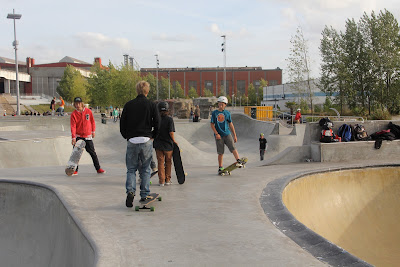 |
| kids on top of the skate park lining up for radness |
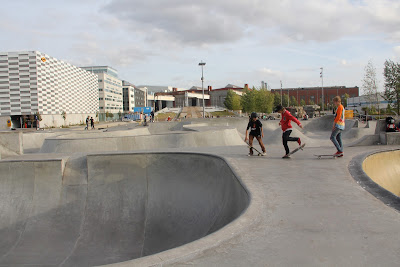 |
| teaching each other new tricks on top of the skate park in Vastra Hamnen |
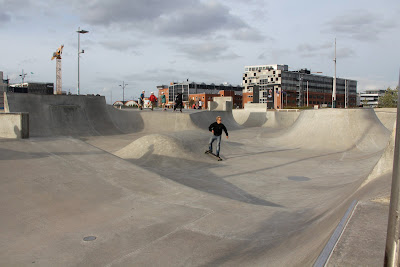 |
| cool dude rolling through the skate park. buildings behind the park (to the east) are now a university and some other businesses and used to be the site where they built submarines. |
 |
| more skate park and skateboarding. be glad I am only posting these few pics. I took way too many. skate parks and skateboarding are cool. |
 |
| if somebody drops into the pool, you have to take a picture |
 |
| roller derby practice at the skate park in Vastra Hamnen. awesome. |
 |
| rock climbing at the skate park |
yep. wind turbines.
Sunday, September 9, 2012
energy company builds (8) showcase apartments
imagine this: NSTAR (or NGRID or whichever energy provider) decides to build (8) showcase experimental apartments as one block, each unit utilizing a different source of energy and systems. the goal: an experiment to see which systems perform better, how each unit interacts with the grid, and to learn valuable lessons about energy use. it seems unimaginable, implausible, downright crazy. crazy like a fox.
 |
| E.ON's energy provider experimental apartment complex with 8 units, each utilizing different methods of creating and collecting energy. |
 |
| E.ON builds 8 showcase experimental apartments in Vastra Hamnen in the Bo04 area across from the skate park |
Subscribe to:
Comments (Atom)






